Page 166 of 561

165 Controls in detail
Control system
Menus, submenus and functions
Menu1
Menu2
Menu3
Menu4
Menu5
Standard display
AUDIO
NAV*
Airmatic/
Compass
Vehicle status message
memory
(�page 168)
(�page 170)
(�page 172)
(�page 172)
(�page 173)
Commands/submenusTrip- and main odometer
Selecting radio station
Show route guidance
instructions, current
direction traveled
Airmatic*
Calling up vehicle malfunction,
warning and system status
messages stored in memory
Checking tire inflation pressure*
Selecting satellite ra-
dio station* (USA only)
Compass
Checking coolant temperature
Operating CD player
Calling up digital speedometer or
outside temperatureCalling up maintenance service
indicatorChecking engine oil leveliThe headings used in the menus table
are designed to facilitate navigation
within the system and are not neces-
sarily identical to those shown in the
control system displays. The first func-
tion displayed in each menu will auto-
matically show you which part of the
system you are in.
Page 169 of 561
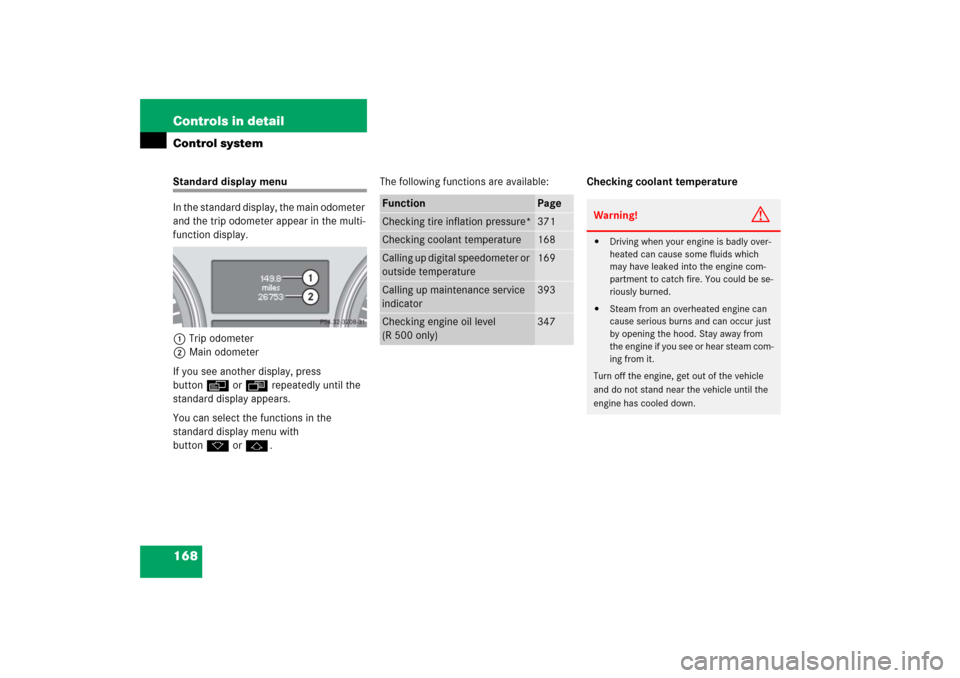
168 Controls in detailControl systemStandard display menu
In the standard display, the main odometer
and the trip odometer appear in the multi-
function display.
1Trip odometer
2Main odometer
If you see another display, press
buttonè orÿ repeatedly until the
standard display appears.
You can select the functions in the
standard display menu with
buttonkorj.The following functions are available:Checking coolant temperature
Function
Page
Checking tire inflation pressure*
371
Checking coolant temperature
168
Calling up digital speedometer or
outside temperature
169
Calling up maintenance service
indicator
393
Checking engine oil level
(R 500 only)
347
Warning!
G
�
Driving when your engine is badly over-
heated can cause some fluids which
may have leaked into the engine com-
partment to catch fire. You could be se-
riously burned.
�
Steam from an overheated engine can
cause serious burns and can occur just
by opening the hood. Stay away from
the engine if you see or hear steam com-
ing from it.
Turn off the engine, get out of the vehicle
and do not stand near the vehicle until the
engine has cooled down.
Page 174 of 561
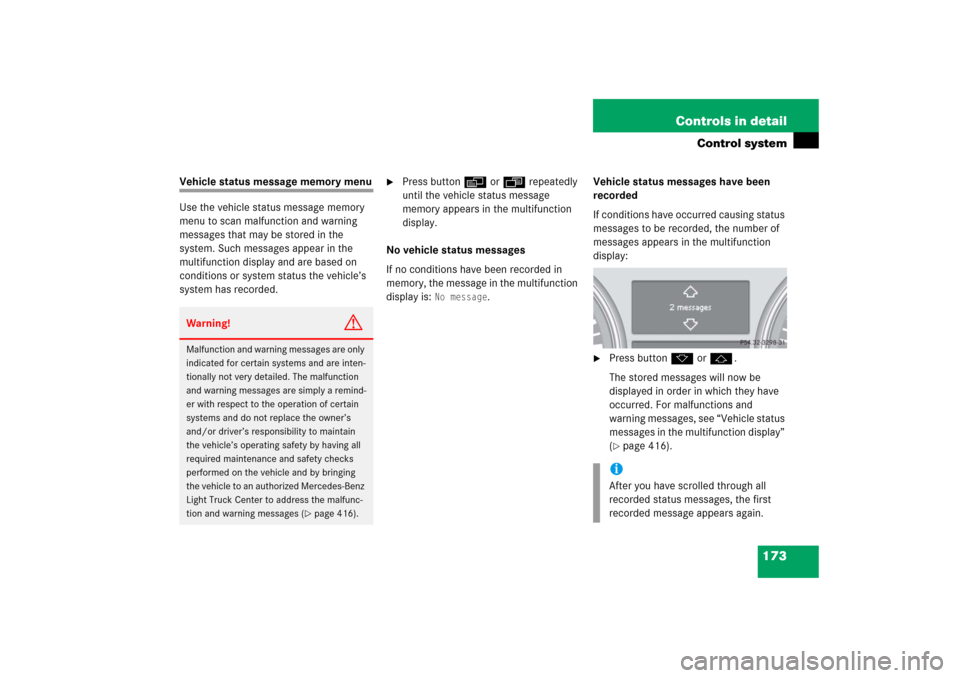
173 Controls in detail
Control system
Vehicle status message memory menu
Use the vehicle status message memory
menu to scan malfunction and warning
messages that may be stored in the
system. Such messages appear in the
multifunction display and are based on
conditions or system status the vehicle’s
system has recorded.
�
Press buttonè orÿ repeatedly
until the vehicle status message
memory appears in the multifunction
display.
No vehicle status messages
If no conditions have been recorded in
memory, the message in the multifunction
display is:
No message
.Vehicle status messages have been
recorded
If conditions have occurred causing status
messages to be recorded, the number of
messages appears in the multifunction
display:
�
Press buttonk orj.
The stored messages will now be
displayed in order in which they have
occurred. For malfunctions and
warning messages, see “Vehicle status
messages in the multifunction display”
(�page 416).
Warning!
G
Malfunction and warning messages are only
indicated for certain systems and are inten-
tionally not very detailed. The malfunction
and warning messages are simply a remind-
er with respect to the operation of certain
systems and do not replace the owner’s
and/or driver’s responsibility to maintain
the vehicle’s operating safety by having all
required maintenance and safety checks
performed on the vehicle and by bringing
the vehicle to an authorized Mercedes-Benz
Light Truck Center to address the malfunc-
tion and warning messages (
�page 416).
iAfter you have scrolled through all
recorded status messages, the first
recorded message appears again.
Page 330 of 561
329 Operation
The first 1000 miles (1500 km)
Driving instructions
At the gas station
Engine compartment
Tires and wheels
Winter driving
Maintenance
Vehicle care
Page 332 of 561
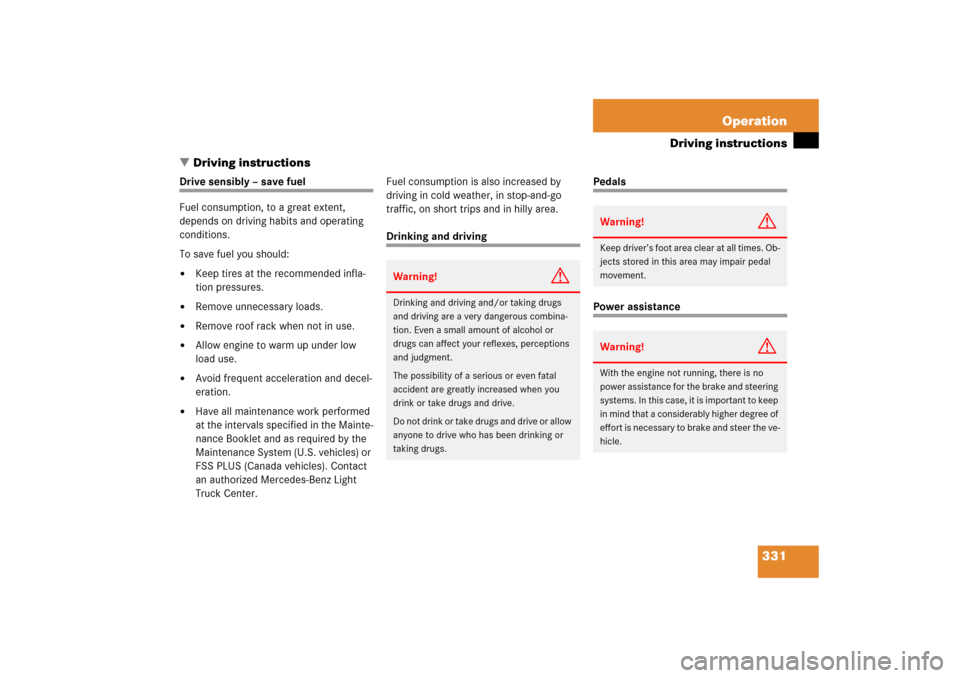
331 Operation
Driving instructions
�Driving instructions
Drive sensibly – save fuel
Fuel consumption, to a great extent,
depends on driving habits and operating
conditions.
To save fuel you should:�
Keep tires at the recommended infla-
tion pressures.
�
Remove unnecessary loads.
�
Remove roof rack when not in use.
�
Allow engine to warm up under low
load use.
�
Avoid frequent acceleration and decel-
eration.
�
Have all maintenance work performed
at the intervals specified in the Mainte-
nance Booklet and as required by the
Maintenance System (U.S. vehicles) or
FSS PLUS (Canada vehicles). Contact
an authorized Mercedes-Benz Light
Truck Center.Fuel consumption is also increased by
driving in cold weather, in stop-and-go
traffic, on short trips and in hilly area.
Drinking and driving
PedalsPower assistance
Warning!
G
Drinking and driving and/or taking drugs
and driving are a very dangerous combina-
tion. Even a small amount of alcohol or
drugs can affect your reflexes, perceptions
and judgment.
The possibility of a serious or even fatal
accident are greatly increased when you
drink or take drugs and drive.
Do not drink or take drugs and drive or allow
anyone to drive who has been drinking or
taking drugs.
Warning!
G
Keep driver’s foot area clear at all times. Ob-
jects stored in this area may impair pedal
movement.Warning!
G
With the engine not running, there is no
power assistance for the brake and steering
systems. In this case, it is important to keep
in mind that a considerably higher degree of
effort is necessary to brake and steer the ve-
hicle.
Page 341 of 561

340 OperationDriving instructionsCatalytic converter
Your Mercedes-Benz is equipped with
monolithic-type catalytic converters, an
important element in conjunction with the
oxygen sensors to achieve substantial con-
trol of the pollutants in the exhaust emis-
sions. Keep your vehicle in proper
operating condition by following our rec-
ommended maintenance instructions as
outlined in your Maintenance Booklet.
Emission control
Certain engine systems serve to keep the
toxic components of the exhaust gases
within permissible legal limits.
These systems, of course, will function
properly only when maintained strictly ac-
cording to factory specifications. Any ad-
justments on the engine should, therefore,
be carried out only by qualified
Mercedes-Benz Light Truck Center autho-
rized technicians.Engine adjustments should not be altered
in any way. Moreover, the specified service
jobs must be carried out regularly accord-
ing to Mercedes-Benz servicing require-
ments. For details refer to the
Maintenance Booklet.
!To prevent damage to the catalytic con-
verters, use only premium unleaded
gasoline in this vehicle.
Any noticeable irregularities in engine
operation should be repaired promptly.
Otherwise, excessive unburned fuel
may reach the catalytic converter,
causing it to overheat and potentially
start a fire.
Warning!
G
As with any vehicle, do not idle, park or op-
erate this vehicle in areas where combusti-
ble materials such as grass, hay or leaves
can come into contact with the hot exhaust
system, as these materials could be ignited
and cause a vehicle fire.
Warning!
G
Inhalation of exhaust gas is hazardous to
your health. All exhaust gas contains carbon
monoxide, and inhaling it can cause uncon-
sciousness and possible death.
Do not run the engine in confined areas
(such as a garage) which are not properly
ventilated. If you think that exhaust gas
fumes are entering the vehicle while driving,
have the cause determined and corrected
immediately. If you must drive under these
conditions, drive only with at least one win-
dow fully open at all times.
Page 350 of 561
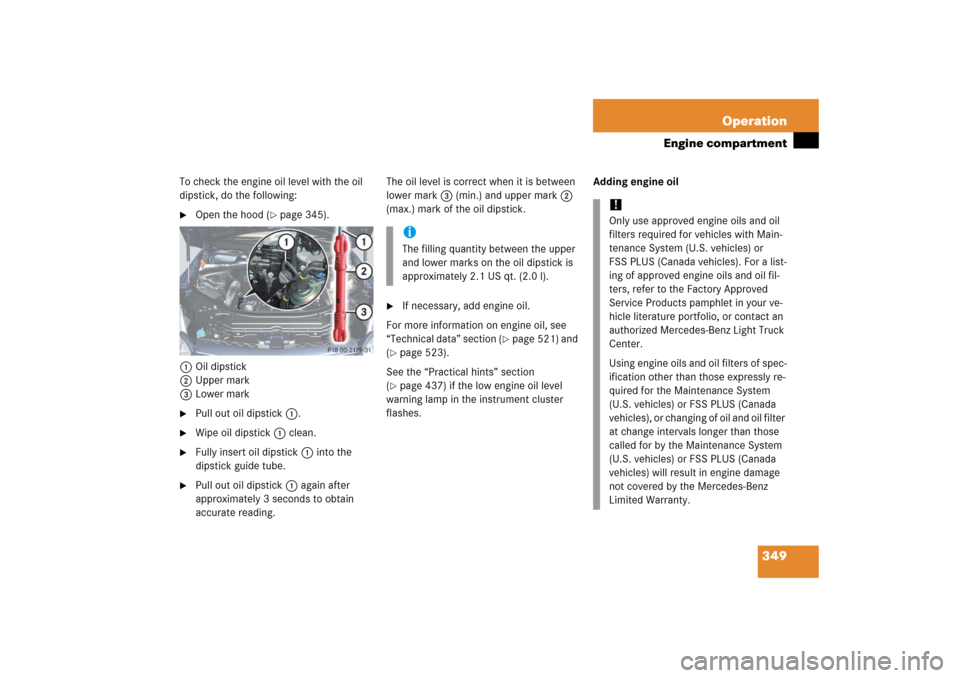
349 Operation
Engine compartment
To check the engine oil level with the oil
dipstick, do the following:�
Open the hood (
�page 345).
1Oil dipstick
2Upper mark
3Lower mark
�
Pull out oil dipstick1.
�
Wipe oil dipstick 1 clean.
�
Fully insert oil dipstick1 into the
dipstick guide tube.
�
Pull out oil dipstick1 again after
approximately 3 seconds to obtain
accurate reading.The oil level is correct when it is between
lower mark 3 (min.) and upper mark 2
(max.) mark of the oil dipstick.
�
If necessary, add engine oil.
For more information on engine oil, see
“Technical data” section (
�page 521) and
(
�page 523).
See the “Practical hints” section
(�page 437) if the low engine oil level
warning lamp in the instrument cluster
flashes.Adding engine oiliThe filling quantity between the upper
and lower marks on the oil dipstick is
approximately 2.1 US qt. (2.0 l).
!Only use approved engine oils and oil
filters required for vehicles with Main-
tenance System (U.S. vehicles) or
FSS PLUS (Canada vehicles). For a list-
ing of approved engine oils and oil fil-
ters, refer to the Factory Approved
Service Products pamphlet in your ve-
hicle literature portfolio, or contact an
authorized Mercedes-Benz Light Truck
Center.
Using engine oils and oil filters of spec-
ification other than those expressly re-
quired for the Maintenance System
(U.S. vehicles) or FSS PLUS (Canada
vehicles), or changing of oil and oil filter
at change intervals longer than those
called for by the Maintenance System
(U.S. vehicles) or FSS PLUS (Canada
vehicles) will result in engine damage
not covered by the Mercedes-Benz
Limited Warranty.
Page 355 of 561
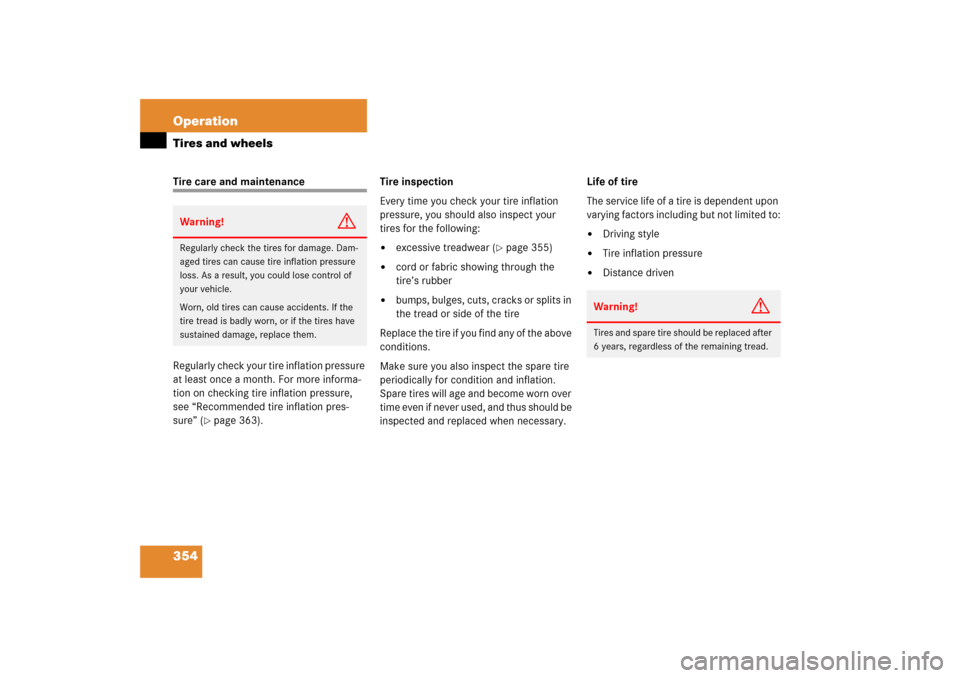
354 OperationTires and wheelsTire care and maintenance
Regularly check your tire inflation pressure
at least once a month. For more informa-
tion on checking tire inflation pressure,
see “Recommended tire inflation pres-
sure” (
�page 363).Tire inspection
Every time you check your tire inflation
pressure, you should also inspect your
tires for the following:
�
excessive treadwear (
�page 355)
�
cord or fabric showing through the
tire’s rubber
�
bumps, bulges, cuts, cracks or splits in
the tread or side of the tire
Replace the tire if you find any of the above
conditions.
Make sure you also inspect the spare tire
periodically for condition and inflation.
Spare tires will age and become worn over
time even if never used, and thus should be
inspected and replaced when necessary.Life of tire
The service life of a tire is dependent upon
varying factors including but not limited to:
�
Driving style
�
Tire inflation pressure
�
Distance driven
Warning!
G
Regularly check the tires for damage. Dam-
aged tires can cause tire inflation pressure
loss. As a result, you could lose control of
your vehicle.
Worn, old tires can cause accidents. If the
tire tread is badly worn, or if the tires have
sustained damage, replace them.
Warning!
G
Tires and spare tire should be replaced after
6 years, regardless of the remaining tread.